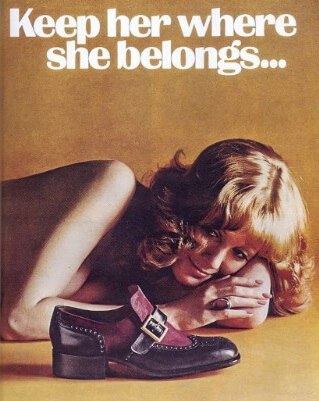Advertisements most often advocate a fantastical pseudo reality where a single product or service can quell all your troubles, and life becomes picture-perfect. A true brain-child of capitalism, they convert our wants into needs. They even redefine and reshape the notions of social dynamics. Consider the plethora of advertisements that tell us we aren’t ‘cool’ enough unless we have that soft drink, and that if we are ‘really’ popular why haven’t we purchased this bike yet?
The fundamental idea behind advertisements is to tell us what we don’t have and what we ought to. Too tired to do the dishes, here’s a dishwasher! Want to crack the job interview for which you’ve been working hard but to no avail, here’s the right perfume for the task! As entertaining as they sometimes are, advertisements are also guilty of something bigger. Most of the time, it isn’t only products that they promote. They sell stereotypes, misogyny, unattainable beauty standards and body norms.
Sexism in advertisements is both on lines of the target audience as well as the portrayal of its featured characters. The former entails what is called gender targeting. Most of us would have noticed that there are certain products which are purely aimed at a specific gender. When they do, it mostly targets women. Think of the countless advertisements for cleaning products, kitchen ware, masalas, condiments, washing machines, baby care products and so on. Apparently whatever concerns the hearth concerns women. Such advertisements are based off stereotypes that propagate age old gender norms and essentialism. It enunciates what feminism fights to erase- traditional gender roles.
Sexism even pervades the parameters by which companies advertise their products. For instance, adverts for female inner garments seem to focus more on comfort, while those for men promise ‘female attention’. Advertisements which look for a masculine appeal to the products, almost always objectify women.
Let’s Sample Some Sexism!
American advertisements from the Mad Men Era (the 1950s and 60s) are infamous for their rampant sexism. At a time when the second wave feminism was in its nascent stage, the American society largely embraced male chauvinism. In a majority of the ads women were dull, subservient, doll-like and meant to be ‘put in their place’. In fact they were so riddled with incapability that the tagline for a twist off ketchup bottle went ‘You mean a woman can open it?’ And not to forget, women are terrible drivers…

A 1970s ad featured in Playboy magazine shows a beautiful, bare-breasted woman lying on the floor gazing at a man’s shoe. The slogan reads: “Keep her where she belongs …”
..and being a housewife was their true calling. A 1969 Ford Cortina advertisement advised men, their primary audience, that if they were to buy their wife the cross-flow Cortina they better make her take a pledge to get all the housework done before driving away to show it off. Here’s a sample of the delightful pledge: ‘I WILL spend more time behind the wheel of the sewing machine than the padded wheel of my Cortina and running through my smooth automatic transmission’
Sneaky Sexism
We might think times have changed. Advertisements are no longer so rashly sexist. Well, Philippa Roberts and Jane Cunningham disagree. Their book Brandsplaining: Why Marketing is (Still) Sexist, exposes that brands appear to adopt gender positivity while still being sexist under the table. The authors call it ‘sneaky sexism’. They point out that when ads are closely looked at they still use age old practises such as objectification and shaming. Tokenism is also a favourite. ‘Weight-loss’ is sold as ‘wellness’ and anti-ageing as ‘ageless’. So instead of saying ‘you aren’t slim enough’ advertisements take a pseudo-good will stance of cheering ‘you can do it!!’
Impact
Tim Parkin, global brand marketing expert, told Forbes magazine that by the time a girl reaches 17 years of age, she would have seen around a quarter of a million advertisements, a majority of which advocate stereotypes. The role of advertisements in gender socialisation could never become more apparent. Girls and boys are taught from a young age to behave a certain way. Since advertisements glorify conventional masculinity and femininity through the stereotypes, they become tools that coerce individuals to play out their assigned parts. Individuals willingly perform their roles for social acceptance, thereby strengthening stereotypes.
The lack of gender inclusivity is apparent in the predominance of heteronormative characters that populate advertisements. The dynamics played out in a majority of ads, albeit problematic, envision a world exclusive to heterosexual cis men and cis women. By vehemently portraying a skewed reality, they ‘advertise’ not only products, schemes or services but systemic discrimination at large.
Femvertising
Femvertising is a change in the course of advertising, where adverts become opportunities to promote images and messages of women and girl empowerment. They tear through the pseudo-reality to present women as they truly are. Dove’s self-esteem project is a wonderful example. When done right, femvertising is a glorious piece of human effort towards gender positivity.
When done right.
On August 7, 2017 the fashion brand Boohoo launched #allgirls, an ‘inclusive’ campaign that missed the mark. It brandished body positivity while failing to include disabled, plus-sized or trans girls among many others. They also brandished a ‘girls of all ages, going through life’s stages’ claim, while coming under heavy criticism for not having casted anyone who looked above 30.
The Unstereotype Alliance
All is not bleak.
A platform convened by Un Women, The Unstereotype Alliance brings together global marketers in an effort to eradicate detrimental gender-stereotypes that are found in media and advertising in a step towards conducing gender equality.
Here’s to hoping that henceforth, the only way we move is forward.

Responses